Step into the past through the Dung Gate, a portal to Jerusalem's biblical stories and mysteries waiting to be unveiled.
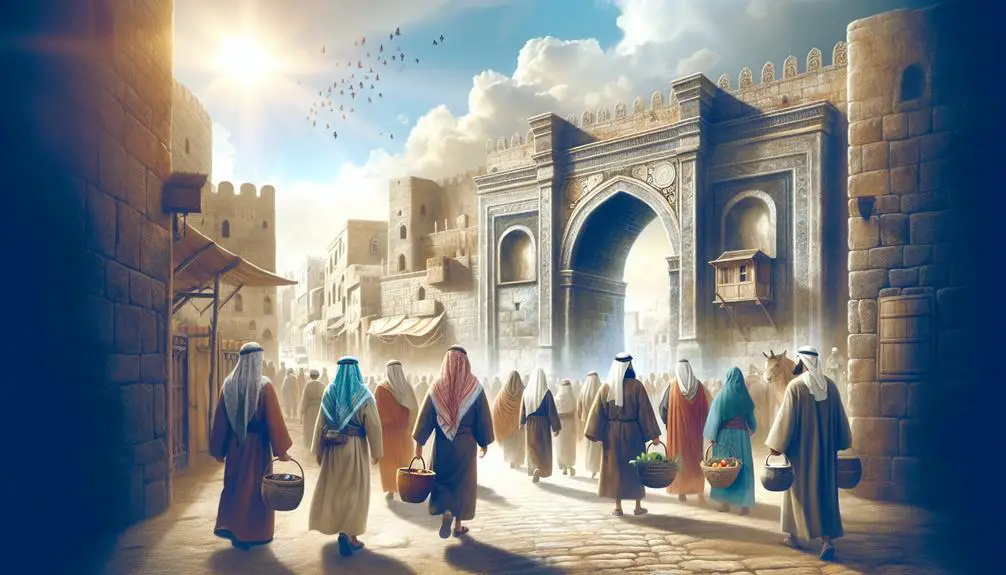
Dung Gate in the Bible
Just as a single thread can start to unravel a vast tapestry, so too can the story of the Dung Gate offer you a unique glimpse into the intricate fabric of biblical history and architecture.
Nestled within the walls of Jerusalem, this gate has borne witness to centuries of history, serving not only as a physical passage but also as a symbol of the city's endurance and transformation.
By exploring its historical context, biblical references, and the layers of meaning attributed to it over time, you'll find yourself at the threshold of a deeper understanding of its enduring significance.
What secrets does the Dung Gate hold, and how do they reflect broader themes within the sacred texts and the ancient city itself?
Key Takeaways
- Dung Gate symbolizes humility and service, pivotal in Jerusalem's socio-religious fabric as outlined in Nehemiah's account.
- It played a crucial role in ancient sanitation, defense, and trade, reflecting Jerusalem's strategic and practical architectural foresight.
- The gate's reconstruction marked a period of purification and renewal, underscoring its spiritual significance in biblical narratives.
- Its restoration efforts highlight its modern significance as a cultural link, tourist attraction, and symbol of Jerusalem's ongoing historical narrative.
Historical Context
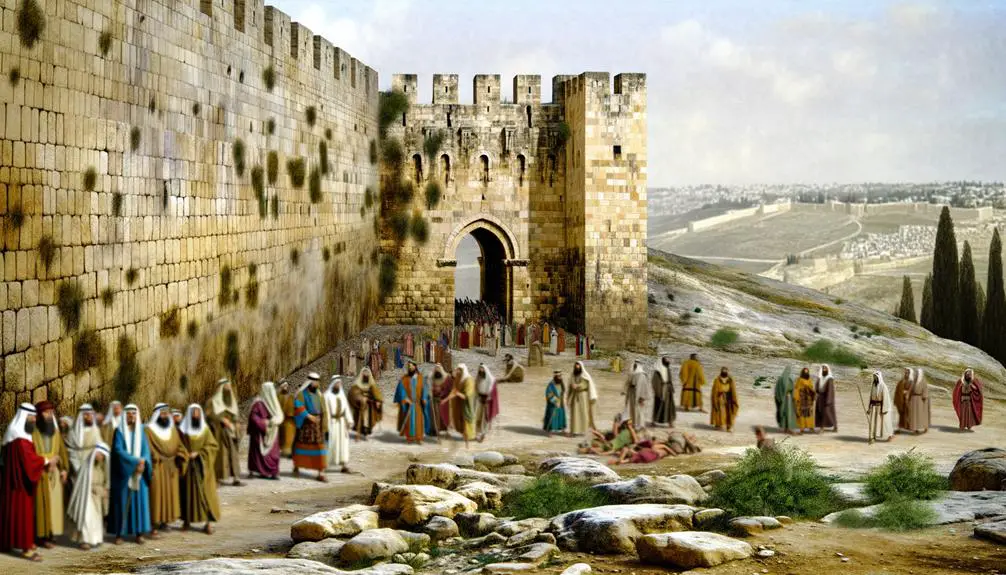
The historical context of the Dung Gate in Jerusalem reveals its pivotal role in the city's sanitation and defense mechanisms throughout ancient times. Situated strategically, this gate wasn't merely a passageway for waste removal but also served as a crucial point in controlling access to the city, especially considering the adjacent trade routes. These routes weren't only vital for the city's economic prosperity but also for its political significance, influencing the power dynamics within the region.
You'd find that the gate's placement was meticulously planned to facilitate the efficient disposal of the city's waste, thereby preventing disease outbreaks which could decimate populations in ancient civilizations. This sanitation function underscores the advanced urban planning and public health awareness of Jerusalem's ancient inhabitants.
Moreover, the proximity of the Dung Gate to critical trade routes meant that it was a linchpin in the city's defense strategy. Controlling access to these routes allowed Jerusalem to exert influence over trade and political alliances, shaping the geopolitical landscape of the region. The gate's role in the city's defenses was compounded by its position on the city's walls, where it could be easily fortified against invaders, yet provide a controlled opening for trade and communication.
The dual role of the Dung Gate, both as a sanitation conduit and a defense mechanism, highlights its importance in the historical and political fabric of ancient Jerusalem. Its strategic placement to optimize both these functions reflects a sophisticated understanding of urban planning, public health, and political strategy, making it a subject of scholarly interest.
Biblical References
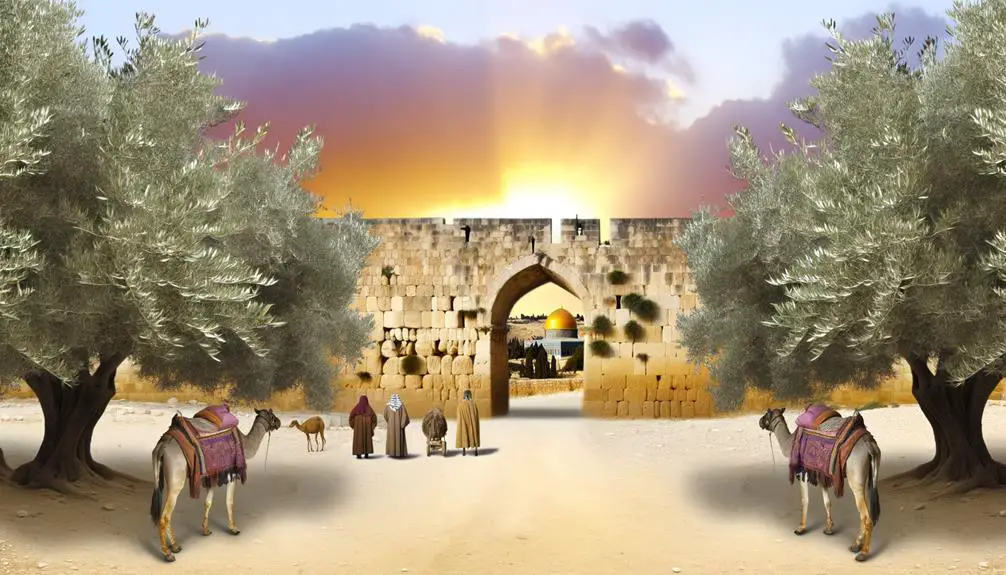
Understanding the historical and architectural significance of the Dung Gate sets the stage for exploring its mentions in biblical texts, where its symbolic and literal roles are further illuminated. This gate, situated in a pivotal geographical location, serves not just as a passageway but as a marker of Jerusalem's southern boundary in the Bible. Its placement and purpose are intricately tied to the city's layout and the daily lives of its inhabitants, showcasing its narrative significance within the scriptural context.
The Dung Gate's mention in Nehemiah 2:13 and 3:13-14, for instance, provides a vivid portrayal of its role during a period of rebuilding and renewal. As you delve into these passages, you observe Nehemiah's nocturnal journey around Jerusalem's walls, where the Dung Gate's condition and its significance in the city's fortifications are highlighted. This not only underscores the gate's physical state but also symbolizes the start of a transformative period for Jerusalem, marking a pivotal point in its recovery and spiritual renaissance.
Furthermore, the gate's geographical location, adjacent to the City of David, enriches its narrative significance. It becomes a symbol of humility and service, a reminder of the mundane yet essential tasks that support a community's daily existence and spiritual well-being. Through biblical references, you're invited to appreciate not just the physical structure of the Dung Gate but its embeddedness in the socio-religious fabric of Jerusalem. This analytical perspective encourages a deeper understanding of how geography and architecture intersect with theology and community life in biblical narratives.
Architectural Features
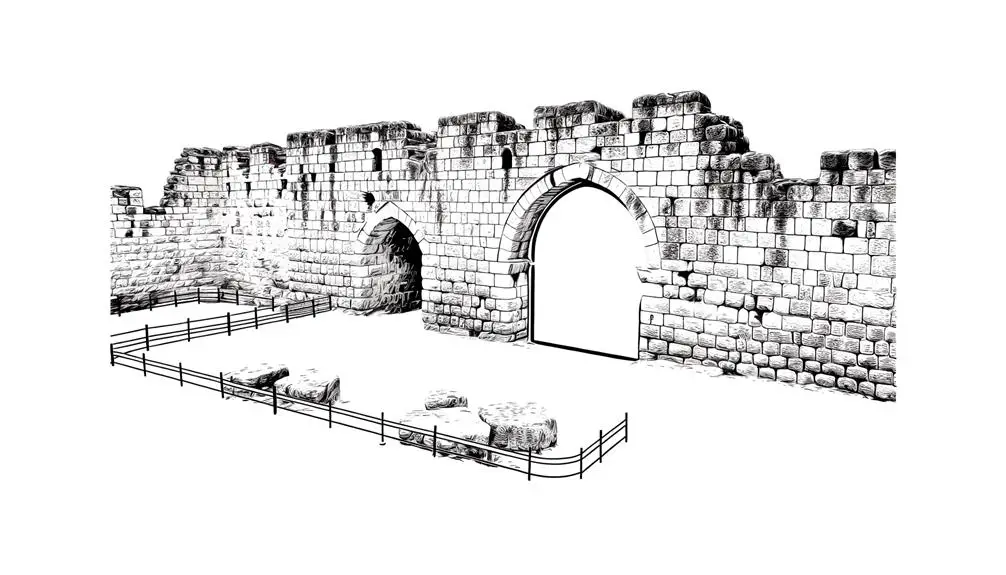
You'll find that the Dung Gate's architectural elements provide a fascinating glimpse into ancient construction techniques and societal priorities.
The gate's design elements, from its size to its decorative features, alongside the materials used in its construction, reflect the technological capabilities and aesthetic values of the period.
A thorough examination of its historical modifications offers insights into the evolving defense strategies and urban development patterns of Jerusalem.
Gate Design Elements
Several architectural features distinguish the Dung Gate's design, each serving a specific function and reflecting the era's construction techniques. You'll notice that gate location and security measures are paramount in its design. The gate's strategic placement not only facilitated the disposal of waste from the city but also contributed to the city's defense mechanism.
Feature |
Function |
|---|---|
Narrow passageways |
Limiting access, enhancing security |
Elevated pathways |
Surveillance and defense |
Thick walls |
Deterrent against invaders |
Outer barbican |
Extra layer of defense |
These elements, intricately woven into the gate's architecture, underscore a blend of practicality and strategic foresight. They reflect a deep understanding of both urban planning and military defense, ensuring the gate's durability and functionality through time.
Construction Materials Used
The choice of construction materials for the Dung Gate's architecture played a crucial role in its resilience and functionality, reflecting meticulous planning and a deep understanding of material properties. By leveraging trade routes, the builders sourced durable stone and timber, materials known for their longevity and strength against the elements.
This strategic sourcing was complemented by tool innovation, which allowed craftsmen to work these materials with unprecedented precision and efficiency. Such innovations included the development of iron chisels and saws, enabling more intricate work on stone and wood, respectively.
The integration of these materials and tools not only showcased the advanced architectural techniques of the time but also ensured that the Dung Gate could withstand the rigors of its role for centuries.
Historical Modifications Overview
Over centuries, architects and builders have implemented significant modifications to the Dung Gate's structure, each reflecting the evolving architectural trends and the gate's enduring importance in urban development. You've observed how the gate's location and the impacts of sieges have necessitated these changes, blending historical integrity with functional modernization.
Aspect |
Description |
|---|---|
Gate Location |
Adapted to urban expansion and strategic defense needs |
Architectural Trends |
Incorporated evolving styles for durability and aesthetics |
Siege Impacts |
Reinforced structures to withstand attacks |
Urban Development |
Modified for improved accessibility and utility |
These modifications underscore the Dung Gate's ability to withstand the test of time, showcasing a remarkable blend of resilience and adaptability in the face of changing architectural trends and the pressing needs of urban development.
Symbolic Meanings
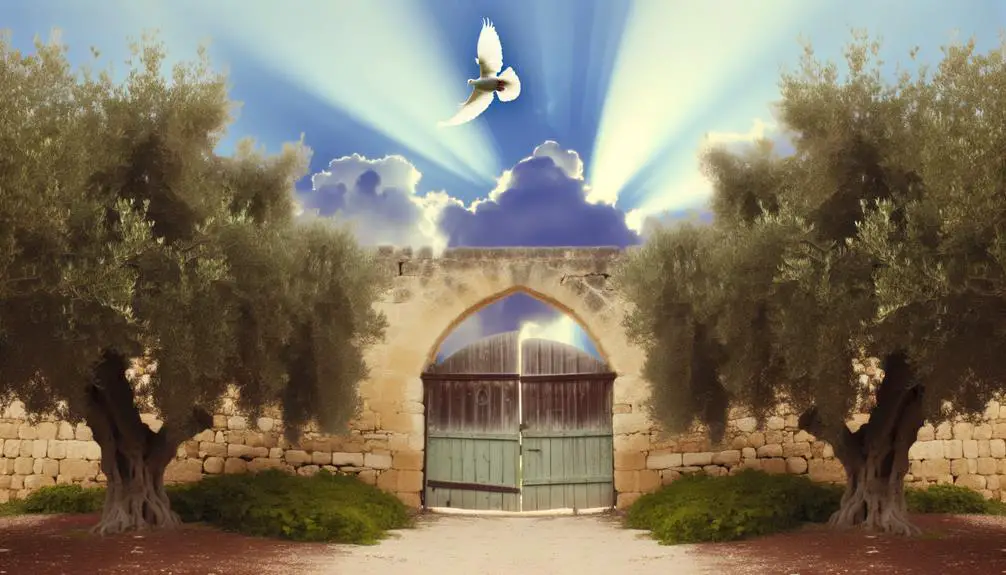
You'll find that the Dung Gate, beyond its physical structure, embodies profound symbolic meanings within the biblical context. It represents not only the purification and renewal process inherent to spiritual practices but also underscores the necessity of humility and spiritual growth as pathways to holiness.
Moreover, this gate's symbolism extends to Jerusalem's holistic cleansing, illustrating how physical spaces mirror spiritual realities.
Purification and Renewal Process
Understanding the symbolic significance of purification and renewal processes in biblical contexts reveals deep layers of spiritual meaning, particularly when examining passages related to the Dung Gate. These concepts aren't only pivotal in ancient rituals but also find contemporary parallels that resonate with our spiritual journeys today.
- Ritual Significance: Purification rituals symbolize the removal of impurities, preparing individuals for a closer relationship with the divine.
- Contemporary Parallels: Modern spiritual practices often echo these ancient rites, emphasizing the need for cleansing one's life of negative influences.
- Cyclical Nature: Just as seasons change, these processes remind us of life's continual cycle of renewal.
- Spiritual Transformation: Undergoing purification is depicted as a crucial step towards spiritual growth and transformation, a journey from the profane towards the sacred.
Humility and Spiritual Growth
In exploring the symbolic meanings of humility and spiritual growth, it's essential to recognize how these virtues serve as foundational pillars in one's journey toward enlightenment and deeper connection with the divine.
Humility, in this context, isn't merely about modesty but involves a profound acknowledgment of one's limitations and the infinite nature of the divine. This realization prompts personal surrender, a willingness to let go of ego-driven desires and submit to a higher will. Such surrender isn't passive but an active engagement in inner transformation.
It requires courage to confront one's imperfections and the discipline to refine oneself through spiritual practices. This path of humility and personal surrender fosters spiritual growth, leading to an enriched understanding of oneself and a more intimate relationship with the divine.
Jerusalem's Holistic Cleansing
Exploring Jerusalem's holistic cleansing reveals complex layers of spiritual purification and renewal that are deeply embedded in its historical and religious narratives. This process isn't just about physical cleanliness but encompasses a broader, symbolic meaning that intertwines ceremonial rituals and urban planning. Here's how:
- Ceremonial Rituals: Serve as a conduit for spiritual purification, symbolizing the shedding of impurities and preparation for divine encounters.
- Urban Planning: Reflects a deliberate design to facilitate both physical and spiritual cleanliness, emphasizing the importance of a purified environment.
- Spatial Organization: The city's layout, including the placement of the Dung Gate, underscores the segregation of impurities from sacred spaces.
- Cultural Practices: Encompass daily activities aimed at maintaining purity, demonstrating a community-wide commitment to holiness.
These elements collectively underscore Jerusalem's deep-seated connection to concepts of purity and renewal.
Restoration Efforts
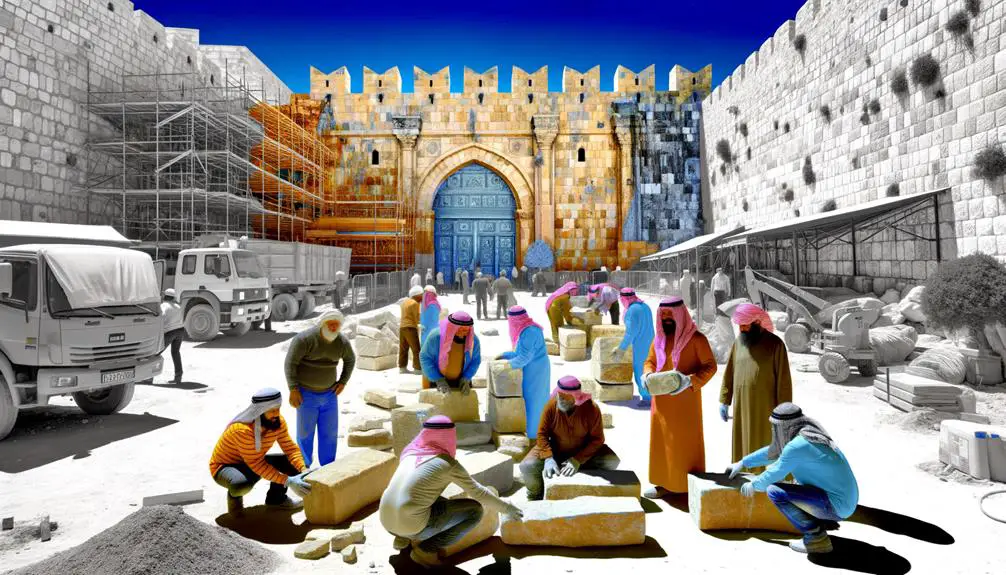
Historically, restoration efforts for the Dung Gate have often involved meticulous planning and execution to preserve its biblical significance and architectural integrity. Funding sources and international collaborations have played crucial roles in these endeavors. Governments, non-profit organizations, and private donors have contributed financially, while experts from various countries have lent their skills and knowledge. This synergy has ensured that the restoration work not only respects the site's historical and religious importance but also adheres to contemporary standards of conservation and archaeology.
The analysis of the Dung Gate's structural composition reveals a complex layering of materials and techniques, indicative of the various periods through which it has stood. Restoration teams have had to decipher this palimpsest, carefully selecting methods that would reinforce the aged structure without compromising its original aesthetic and material essence. This process involves a detailed study of historical records, architectural surveys, and even microscopic analysis of mortar and stone samples.
Moreover, the restoration of the Dung Gate incorporates modern technologies alongside traditional techniques. Laser scanning and 3D modeling have facilitated a precise understanding of the gate's condition, allowing for targeted interventions. At the same time, craftsmen skilled in ancient masonry and carpentry methods have been essential in recreating the textures and forms characteristic of the gate's period.
Modern Significance
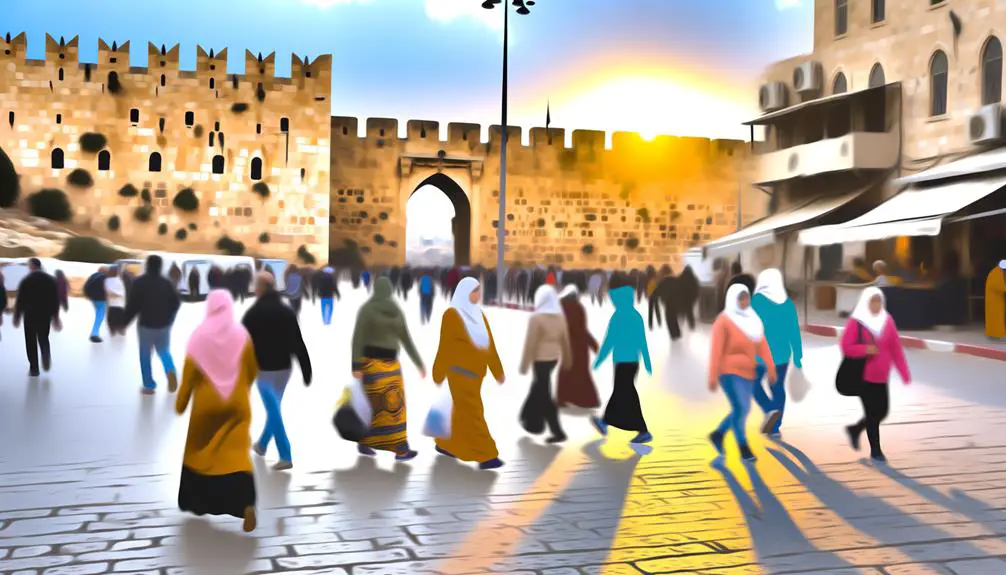
Despite advancements in technology and changing societal values, the Dung Gate's significance remains undiminished, serving as a vital link between the past and present for scholars, believers, and visitors alike. Its modern relevance can be dissected into several key aspects:
- Tourist Attraction: The Dung Gate today stands as a testament to millennia of history, drawing in countless tourists each year. You're not just visiting a historical site; you're stepping into a story that crosses the boundaries of time. The gate's proximity to significant religious and historical landmarks adds layers to its appeal, making it a must-visit for anyone seeking to understand the intricate tapestry of Jerusalem's past.
- Cultural Significance: For believers and scholars, the gate is a tangible connection to the biblical narratives, providing a unique perspective on the sacred texts. Its preservation allows for a deeper appreciation of the historical context surrounding biblical events, enriching faith and scholarly research.
- Political Implications: In today's geopolitical landscape, the Dung Gate holds considerable political significance. Its location and access control have implications for the delicate balance of power in Jerusalem, reflecting broader regional tensions. Understanding its political dimension is crucial for grasping the complexities of Middle Eastern politics.
- Educational Value: The gate serves as an invaluable educational tool, offering insights into ancient engineering, urban planning, and the socio-political structures of past societies. It's a vivid illustration of how history shapes and is shaped by human ingenuity and ambition.
In essence, the Dung Gate's modern significance is multi-faceted, embodying the intersection of history, faith, politics, and culture. Its relevance today transcends mere archaeological interest, offering a window into the enduring human story.
Frequently Asked Questions
How Has the Name "Dung Gate" Influenced Cultural or Literary Works Outside of Religious Texts?
The name 'dung gate' has permeated cultural and literary works as a potent symbol of purification and expulsion of the unwanted. You'll find it's not just a historical artifact but a rich source of literary symbolism and cultural metaphors.
Writers and artists have drawn on this imagery to explore themes of renewal and rejection. It serves as a vivid backdrop against which human struggles and societal cleansing are depicted, elevating narratives with its multi-layered significance.
What Specific Events or Festivals in Contemporary Jerusalem Involve the Dung Gate, That Aren't Tied to Its Historical or Biblical Significance?
You'll find that contemporary Jerusalem celebrates various events near the Dung Gate, detached from its biblical connotation. Notably, the Jerusalem Marathon showcases this area, drawing participants globally.
Moreover, art installations enliven the vicinity, offering a modern cultural dimension that transcends historical narratives. These activities underline the gate's evolving relevance, transforming it from a historical footnote into a vibrant hub for communal and international gatherings, illustrating its multifaceted role in today's Jerusalem.
Are There Any Unique Traditions or Practices Among Local Communities Specifically Related to the Dung Gate?
You'll find that around the Dung Gate, unique traditions or practices aren't just historical footnotes. Instead, gate renovations and community artistry take center stage.
Local residents often engage in beautifying the area, transforming it into a canvas that reflects contemporary culture rather than biblical tales. This blend of modern aesthetics and communal efforts showcases a vibrant, living tradition that continually redefines the gate's significance in the heart of Jerusalem.
How Do Environmental and Urban Planning Policies in Jerusalem Today Impact the Area Around the Dung Gate, Considering Its Historical Value?
In Jerusalem, urban growth and conservation efforts around the Dung Gate area are meticulously balanced.
You'll find that policies strictly regulate development, preserving its historical essence while accommodating modern needs.
These measures ensure that any expansion or renovation doesn't compromise the area's rich past.
The focus is on sustainable urban planning that respects the site's significance, blending the old with the new in a harmonious way that honors its heritage.
What Are the Challenges Faced by Tour Guides or Educators When Explaining the Significance of the Dung Gate to Visitors From Diverse Cultural and Religious Backgrounds?
When you're tackling the task of explaining the Dung Gate's significance to a varied audience, you're bound to face interpretation challenges.
It's crucial to weave cultural sensitivity into your narrative. Each visitor brings their unique background, potentially complicating their understanding and appreciation.
Your goal's to bridge these gaps, ensuring your explanation resonates across different perspectives. This demands a detailed, analytical approach, tailoring your narrative to engage and enlighten your audience.
Conclusion
In conclusion, you've journeyed through the dung gate's historical layers, unearthing its biblical roots, architectural intricacies, and symbolic depths. Isn't it fascinating how this seemingly mundane structure reflects broader societal and spiritual narratives?
Restoration efforts breathe new life into its stones, underscoring its enduring relevance. As you reflect on the dung gate's multifaceted legacy, consider its modern significance. Does it not challenge us to find beauty and meaning in the most unexpected places?



Sign up